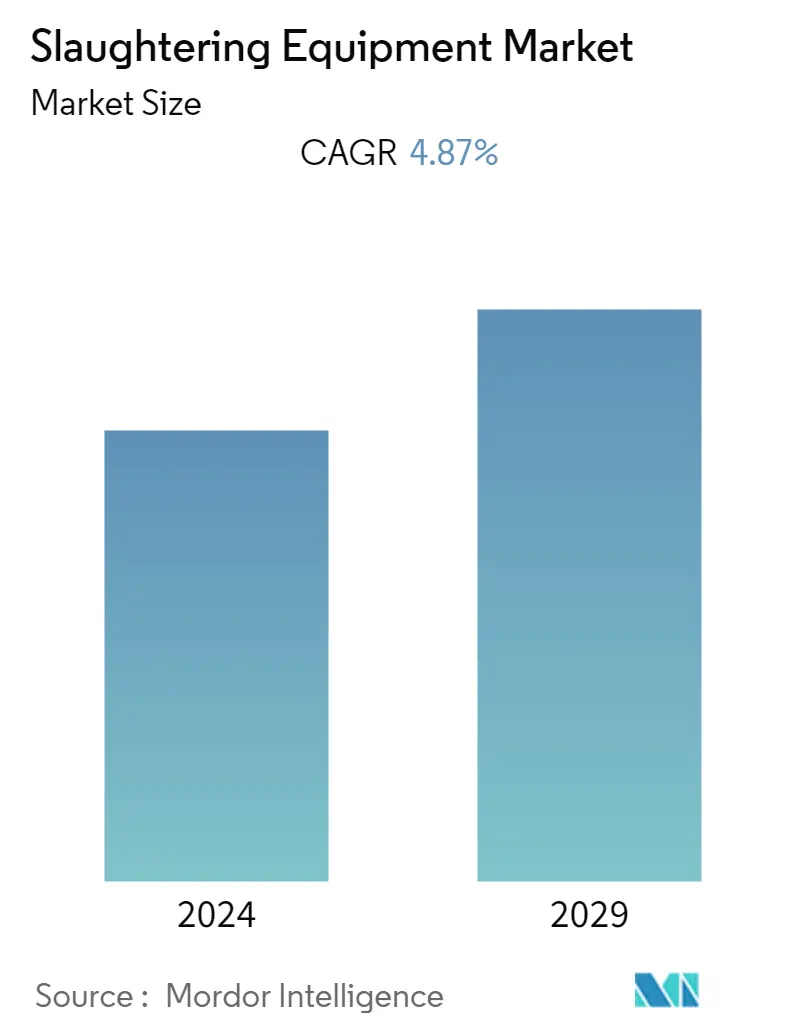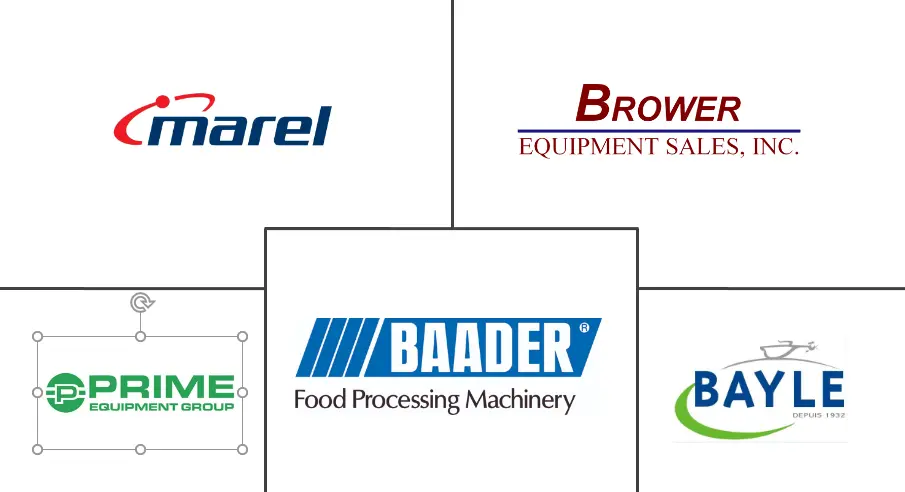Market Size of Slaughtering Equipment Industry

| Study Period | 2019 - 2029 |
| Base Year For Estimation | 2023 |
| CAGR | 4.87 % |
| Fastest Growing Market | Asia Pacific |
| Largest Market | North America |
| Market Concentration | Low |
Major Players
*Disclaimer: Major Players sorted in no particular order |
Slaughtering Equipment Market Analysis
The global slaughtering equipment market is projected to grow, witnessing a CAGR of 4.87% during the forecast period (2020-2025).
- The enormous growth in the fast food and restaurant chains, growing demand for processed food, technological advancement in automation, and lenient trade policies in exporting meats are expected to be driving the growth in the global slaughtering equipment market. A recent trend in collaboration between meat processing companies and slaughtering equipment manufacturers due to the rapid technological advancement are anticipated to be boosting the growth in the global slaughtering equipment market.
- This demand for semi-automated slaughtering equipment is poised to increase as they benefits many small slaughterhouses by enabling faster delivery and accuracy. Moreover, slaughtering equipment enhances the quality, appearance, and marketability of the end-product. It provides clean and hygienic products.
Slaughtering Equipment Industry Segmentation
The scope of the global slaughtering equipment market includes the segmentation of the market by Type, by Automation, by Livestock and by Geography. The segmentation by equipment type includes Stunning, Killing, Cut-Up, Deboning & Skinning, Evisceration, and Others. By automation market is segmented into Fully Automated Line, and Semi-Automated Line. Further, the market is segmented by livestock which includes Poultry, Swine, Bovine, Seafood, and Others.
| By Type | ||||
| ||||
| Killing | ||||
| Cut-Up | ||||
| Deboning & Skinning | ||||
| Evisceration | ||||
| Others |
| By Automation | |
| Fully Automated Line | |
| Semi-Automated Line |
| By Livestock | |
| Poultry | |
| Swine | |
| Bovine | |
| Seafood | |
| Others |
| By Geography | |||||||||
| |||||||||
| |||||||||
| |||||||||
| |||||||||
|
Slaughtering Equipment Market Size Summary
The global slaughtering equipment market is experiencing significant growth, driven by factors such as the expansion of fast food and restaurant chains, increasing demand for processed foods, and advancements in automation technology. Lenient trade policies in meat exports further contribute to this growth. A notable trend is the collaboration between meat processing companies and equipment manufacturers, which is enhancing market expansion. The demand for semi-automated slaughtering equipment is rising, as it offers benefits like faster delivery and improved accuracy, particularly for small slaughterhouses. This equipment also enhances the quality and marketability of meat products, ensuring they are clean and hygienic. The increasing global demand for various meat products, coupled with stringent regulations for meat processing facilities, is driving operators to adopt automated slaughtering solutions to maintain hygiene and safety.
Regionally, North America is poised to lead in market growth due to the proliferation of fast food chains, a rising number of restaurants, and a growing demand for processed meats. The Asia Pacific region also shows promising growth, attributed to high meat consumption, increased awareness of hygienic and quality meat products, and a growing urban population. Key manufacturers in the market, such as Marel, BADDER Group, and BAYLE SA, offer diversified product portfolios and advanced technologies, strategically positioning themselves in major markets. These companies are instrumental in driving the market forward, leveraging their expertise to meet the evolving demands of the slaughtering equipment industry.
Slaughtering Equipment Market Size - Table of Contents
-
1. MARKET DYNAMICS
-
1.1 Market Drivers
-
1.2 Market Restraints
-
1.3 Porters 5 Force Analysis
-
1.3.1 Threat of New Entrants
-
1.3.2 Bargaining Power of Buyers/Consumers
-
1.3.3 Bargaining Power of Suppliers
-
1.3.4 Threat of Substitute Products
-
1.3.5 Intensity of Competitive Rivalry
-
-
-
2. MARKET SEGMENTATION
-
2.1 By Type
-
2.1.1 Stunning
-
2.1.1.1 Electrical Stunning
-
2.1.1.2 Controlled Atmosphere Stunning
-
-
2.1.2 Killing
-
2.1.3 Cut-Up
-
2.1.4 Deboning & Skinning
-
2.1.5 Evisceration
-
2.1.6 Others
-
-
2.2 By Automation
-
2.2.1 Fully Automated Line
-
2.2.2 Semi-Automated Line
-
-
2.3 By Livestock
-
2.3.1 Poultry
-
2.3.2 Swine
-
2.3.3 Bovine
-
2.3.4 Seafood
-
2.3.5 Others
-
-
2.4 By Geography
-
2.4.1 North America
-
2.4.1.1 United States
-
2.4.1.2 Canada
-
2.4.1.3 Mexico
-
2.4.1.4 Rest of North America
-
-
2.4.2 Europe
-
2.4.2.1 Germany
-
2.4.2.2 United Kingdom
-
2.4.2.3 France
-
2.4.2.4 Russia
-
2.4.2.5 Spain
-
2.4.2.6 Italy
-
2.4.2.7 Rest of Europe
-
-
2.4.3 Asia-Pacific
-
2.4.3.1 India
-
2.4.3.2 China
-
2.4.3.3 Japan
-
2.4.3.4 Australia
-
2.4.3.5 Rest of Asia-Pacific
-
-
2.4.4 South America
-
2.4.4.1 Brazil
-
2.4.4.2 Colombia
-
2.4.4.3 Rest of South America
-
-
2.4.5 Middle East and Africa
-
2.4.5.1 South Africa
-
2.4.5.2 Saudi Arabia
-
2.4.5.3 Rest of Middle East and Africa
-
-
-
Slaughtering Equipment Market Size FAQs
What is the current Slaughtering Equipment Market size?
The Slaughtering Equipment Market is projected to register a CAGR of 4.87% during the forecast period (2024-2029)
Who are the key players in Slaughtering Equipment Market?
Marel, BAADER Group, Bayle SA, Prime Equipment Group, Inc. and Brower Equipment are the major companies operating in the Slaughtering Equipment Market.

